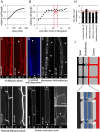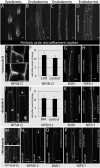A developmental framework for endodermal differentiation and polarity
- PMID: 20142472
- PMCID: PMC2841941
- DOI: 10.1073/pnas.0910772107
A developmental framework for endodermal differentiation and polarity
Abstract
The endodermis is a root cell layer common to higher plants and of fundamental importance for root function and nutrient uptake. The endodermis separates outer (peripheral) from inner (central) cell layers by virtue of its Casparian strips, precisely aligned bands of specialized wall material. Here we reveal that the membrane at the Casparian strip is a diffusional barrier between the central and peripheral regions of the plasma membrane and that it mediates attachment to the extracellular matrix. This membrane region thus functions like a tight junction in animal epithelia, although plants lack the molecular modules that establish tight junction in animals. We have also identified a pair of influx and efflux transporters that mark both central and peripheral domains of the plasma membrane. These transporters show opposite polar distributions already in meristems, but their localization becomes refined and restricted upon differentiation. This "central-peripheral" polarity coexists with the apical-basal polarity defined by PIN proteins within the same cells, but utilizes different polarity determinants. Central-peripheral polarity can be already observed in early embryogenesis, where it reveals a cellular polarity within the quiescent center precursor cell. A strict diffusion block between polar domains is common in animals, but had never been described in plants. Yet, its relevance to endodermal function is evident, as central and peripheral membranes of the endodermis face fundamentally different root compartments. Further analysis of endodermal transporter polarity and manipulation of its barrier function will greatly promote our understanding of plant nutrition and stress tolerance in roots.
Conflict of interest statement
The authors declare no conflict of interest.
Figures




References
-
- Enstone DE, Peterson CA, Ma F. Root endodermis and exodermis: Structure, function, and responses to the environment. J Plant Growth Regul. 2002;21:335–351.
-
- Cui H, et al. An evolutionarily conserved mechanism delimiting SHR movement defines a single layer of endodermis in plants. Science. 2007;316:421–425. - PubMed
-
- Ma JF, et al. An efflux transporter of silicon in rice. Nature. 2007;448:209–212. - PubMed
Publication types
MeSH terms
Substances
LinkOut - more resources
Full Text Sources
Other Literature Sources
Research Materials

